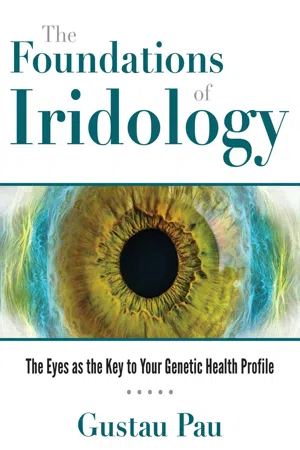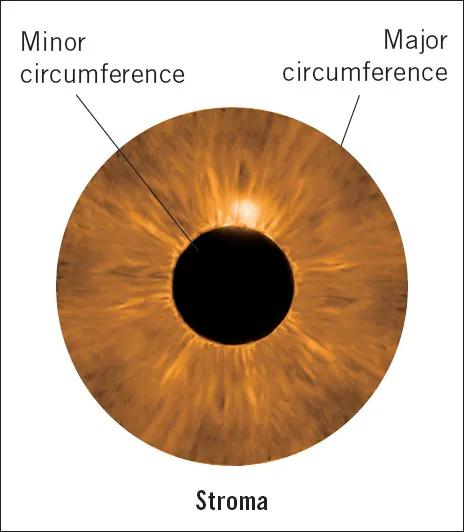![]()
1
Anatomy and Physiology of the Eye
As embryos we have two hearts, which later fuse to form one, what a pity; and we have one single eye, which later splits in two, how lucky.
FRANCISCO ORTS LLORCA
OCULAR ANATOMY
The eyeball has a spherical shape that is slightly flattened in relation to its vertical axis. The cornea, which is transparent, is located in the front part of the eye, forming a protuberance on the surface. The eyeball is made up of membrane formations (enveloping membranes) called the sclera, choroid, and retina, as well as transparent, refractive liquid and solid elements (the cornea, aqueous and vitreous humor, and lens).
The iris is the front part of the choroid, and its movement inspired the diaphragmsused on photographic cameras. The iris has a delicate consistency; it is twelve to thirteen millimeters in diameter and averages just three-tenths of a millimeter in thickness. It has two surfaces (anterior and posterior) and two circumferences (major and minor).
From the anterior to the posterior, the iris is composed of the endothelium, the stroma, and a posterior pigmented layer.
Endothelium
This layer of flattened polygonal cells forms a continuum in contact with the aqueous humor (the liquid found in the anterior chamber of the eye).
Stroma
The stroma is the tissue of the iris, formed by connective tissue, chromatophore cells, muscle fibers, neurofilaments, blood and lymphatic vessels, and a basement membrane. It has a deep layer with a one-millimeter-wide annular ring of muscle fibers (sphincter) whose contraction decreases the size of the pupil.
Posterior Pigmented Layer
At the rear of the iris are two rows of dark purple-colored retinal epithelial cells. They protrude from the minor circumference of the iris, surrounding the pupil.
INNERVATION
The iris is innervated by the autonomic nervous system, with thoracolumbar sympathetic branches and craniosacral parasympathetic branches.
The annular muscle fibers and ciliary muscle are innervated by the short ciliary nerve branch of the oculomotor nerve (cranial nerve III), which originates in the midbrain.
The fibers of the dilator muscle are innervated by the long ciliary nerves, which are connected to the sympathetic cervical ganglion.
These nerves reach the iris through the choroid layer of the eyeball, forming the iridian plexus, from where they are distributed to the muscle fibers and other structures of the iris. Some neurofilaments form a network or mesh on the subendothelial surface. This sensitive mesh is made up of triangular units having concentric circumferences and vertices pointing toward the pupil; the triangles located at the periphery of the iris have larger bases. The sides of these triangular units coincide with tiny vessels and neurofilaments. Furthermore, there is another deep nerve network with a motor component.
In terms of motor units, the iris is the most sensitive in the body. As comparison, a leg muscle might allocate 120 muscle fibers per motor unit. The iris muscles require the impressive number of one to eight fibers per motor unit—that is, enormous specificity for such a small anatomic space.
Nerve Connections
The direct connection of the neurofilaments on the superficial layers of the iris with the cervical ganglion of the sympathetic system and the ciliary ganglion of the parasympathetic system explains how the impressions of the whole organism can be sent to the iris and lets us understand how the tissue of the iris receives nerve signals and blood with energetic and biochemical information from other parts of the body. This information generates iridology signs on the surface of the iris. We know that each part of the organism (form and function) is represented on a certain part of the iris. In regards to this relationship, one of the hardest tasks in iridology, which is also without a doubt the most delicate one, is to accurately determine the areas that correspond to each organ, function, and body part, a task that has not yet been concluded.
By daily observation of this small and delicate part of our anatomy, we believe that we can establish a series of postulates that clearly summarize the possibilities of iridology and its reflexive function, moving away from unsupported definitions like the ones we find in the Pschyrembel clinical dictionary, which states: “Iridology: method to recognize diseases in the rest of the body through observation, which is scientifically inadmissible.”
(Evidently, if you fall into the trap of thinking that the iris can be used to identify diseases, i.e., pathologies, you will simply have to change your thinking because it is completely wrong.)
Principles of Iridology
In synthesis, we believe that to use iridology effectively, you must adhere to the following points and principles:
- Time does not modify the structure of the iris, but it modifies its appearance.
- The absence of signs does not necessarily mean good health.
- Iridology does not diagnose diseases.
- Treatments do not modify the structure of the iris, although at times they can modify its appearance.
USES OF IRIDOLOGY
- To gauge a person’s disposition toward illness
- To identify the origins of a disease
- To identify causal relationships for illness
- To identify the most appropriate healing orientation
- To provide an overview of a person’s health
- To assess the relationship between parts
- To identify the most effective preventive health-care measures
ASSESSMENTS THROUGH THE IRIS
- Vital tone
- Ability to recuperate
- Life expectancy
- Nutritional status
- Tissue regeneration capacity
- Unreactive zones (zones that do not respond to stimuli)
- Connective muscle tone
- Nerve strength
- Suppressions
- Libido
- Iatrogenesis indicators
- Predisposition to cardiovascular symptoms
- Recovery indicators
- Irritation points
- Catarrhal sectors
- Endocrine lability (i.e., endocrine vulnerability)
CONDITIONS REFLECTED IN SIGNS ON THE IRIS
- Time
- Intensity
- Absence of blockage
- Affinity or temperament
- Genetics
- Trauma
HERING’S LAW
Iridology, which since its creation has coexisted with homeopathy, lets us give a more practical meaning to the axiom proposed by Constantine Hering, an early pioneer in homeopathy. We are talking of the renowned Hering’s law,*1 which we can use in conjunction with iridological observation to look for the path to healing, the path to well-being, and the path of disease, or, with more audacity, the causal identification of disease. It has been our experience that iridology consultations identify some type of chronic disorder in seven out of ten people who say they feel fine. This fact should motivate us to aspire to above-average health in comparison to the general population.
Iridologist Henry Lindlahr contributed to this matter by stating that the path to disease was due mainly to three typically human behaviors: ignorance, convenience, and negligence. An incorrect diet, the wrong job, erroneous thoughts, and inadequate personal relationships are consequences of these behaviors and can be causal factors leading us to ailments.
Modern society has adopted the philosophy of relief (“getting by”), where people take drugs that are often unnecessary and that potentiate or stimulate antiphysiological habits, in addition to causing unwanted effects. With medication to prop us up, we go forward in our lives having made very few fundamental changes or none at all, letting day-to-day inertia carry us, and forgetting that nature is always changing. Following this line of thought, a curios aphorism by Hippocrates states that change is good when we want to train ourselves to face fortuitous changes: “Those things which one has been accustomed to for a long time, although worse than things which one is not accustomed to, usually give less disturbance; but a change must sometimes be made to things one is not accustomed to.”*2
Based on the reflections of health and physiological tendencies that it reveals to us, the iris shows us which changes we must undertake, how to retrace a wrong path, and how to distance ourselves from our “enemies.” Getting rid of a bad habit little by little rarely works; if you are certain of the path, you must be strict and relentless and completely dive in. The first task is to change our way of thinking (from top to bottom and from the inside out, as Hering would say), throw away the obsolete and the burdensome, and assimilate the new. In others words, we must act differently than the average and separate ourselves from social inertia and the latest fads.
Some people, despite the obvious anatomical relationship between the iris and the person as a whole, doubt these fundamentals and, thus, the reliability of their reading. Well, for those who still harbor doubts, there are some very interesting physiological relationships that are not usually argued but may shed light on the matter. To begin, it is important for these people to reflect on the embryological origin of the nervous system and in particular the iris, which, though it has muscular structures, is derived not from the myotome (the embryonic structure from which...




